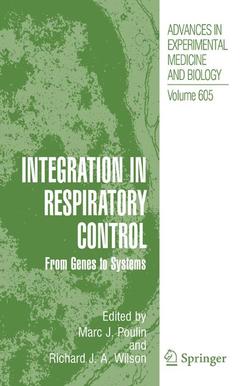Description
Integration in Respiratory Control, Softcover reprint of hardcover 1st ed. 2008
From Genes to Systems
Advances in Experimental Medicine and Biology Series, Vol. 605
Coordinators: Poulin Marc, Wilson Richard J. A.
Language: English
Subjects for Integration in Respiratory Control:
Integration in respiratory control: from genes to systems (paperback) previously published in hardcover (series: advances in experimental
Publication date: 11-2010
542 p. · 16.5x24.8 cm · Paperback
Publication date: 11-2010
542 p. · 16.5x24.8 cm · Paperback
Integration in respiratory control: from genes to systems
Publication date: 11-2007
542 p. · 15.5x23.5 cm · Hardback
Publication date: 11-2007
542 p. · 15.5x23.5 cm · Hardback
Description
/li>Contents
/li>Comment
/li>
Like the geological treasures that surely must lie below the Athabasca glacier, some of the answers to key questions about the control of respiration remain buried. But bit by bit, year by year the ice is melting and perhaps in some areas the rocks are starting to be revealed. With a mission to advance our understanding of the emerging th th gems of respiration, the X Oxford Conference was held between 19?24 September (2006) next to the turquoise and tranquil waters of Lake Louise, in the middle of Banff National Park, Alberta, Canada. Since its inauguration 30 years ago in Oxford, the Oxford Conference on mo- ling and control of breathing has been held every three years in locations spanning the globe (a list of past conferences and publications that have emerged is included in the pages that follow). The series has provided key opportunities for respiratory scientists to meet with colleagues, discuss recent advances and celebrate their field. The 2006 Lake Louise meeting was Canada?s second Oxford Conference; the th previous Canadian meeting (the VII Oxford Conference) was held in 1997 at the Grandview Inn in Huntsville (Ontario) and was chaired by Richard Hughson, David Cunningham and Jim Duffin.
Historical and Future Perspectives of the Control of Breathing.- Oxygen Sensing and the Carotid Body.- Respiratory Rhythm Generation.- Genes and Development.- Models of Gas Exchange.- Plasticity and Adaptation.- Neuromodulation.- Comparative Aspects.- Central Chemosensitivity.- Brainstem Mechanisms Underlying Cardio-Respiratory Control.- Multifunctional and Reconfiguring Networks.- Clinical Perspectives: Modeling and Control of Breathing (i.e., Sleep Apnea).
Contains the most up-to-date research in cardio-respiratory control Content spans the disciplines of respiratory physiology, neurobiology, modeling, and biomedical engineering Will be of interest to clinicians working with patients with breathing disorders
© 2024 LAVOISIER S.A.S.




